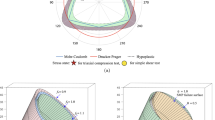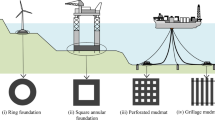Abstract
Induced anisotropy is known to play a major role in the undrained strength of clays, especially in case of weakly consolidated deposits. This paper discusses undrained failure in soft clays in light of material stability principles. For this purpose, a strain-hardening elastoplastic model widely used to study undrained instability in isotropic soils is enhanced to account for stress-induced anisotropy. A versatile yield function able to flexibly control the shape of the elastic domain is augmented through a hardening variable related to the evolving fabric, while rotational hardening is used to replicate the reorientation of the surface as a function of the loading history. Parametric analyses are used to illustrate the model capabilities, and instability indices for undrained failure are derived in analytical form. Finally, the model performance is tested against experimental evidence available for two widely tested soils: soft Chicago clay and Boston blue clay. The analyses illustrate how the proposed model allows an accurate representation of soil responses under extension and compression paths. In addition, it enables the identification of undrained failure resulting from the monotonic growth of shear stresses, as well as from a post-peak strength decay.












Similar content being viewed by others
References
Schofield AN, Wroth CP (1968) Critical state soil mechanics. McGrow-Hill, London
Wood MD (1990) Soil behaviour and critical state soil mechanics. Cambridge University Press, Cambridge
Oda M (1972) Initial fabrics and their relations to mechanical properties of granular material. Soils Found 12(1):17
Yoshimine M, Ishihara K, Vargas W (1998) Effects of principal stress direction and intermediate principal stress on undrained shear behavior of sand. Soils Found 38(3):179
Oda M, Nemat-Nasser S, Konishi J (1985) Stress-induced anisotropy in granular masses. Soils Found 25(3):85
Ohta H, Hata S (1971) In: Proceedings of the Japan society of civil engineers, vol 1971. Japan Society of Civil Engineers, pp 117–124
Dafalias YF (1986) An anisotropic critical state soil plasticity model. Mech Res Commun 13(6):341
Pestana JM, Whittle AJ, Gens A (2002) Evaluation of a constitutive model for clays and sands: part II-clay behaviour. Int J Numer Anal Methods Geomech 26(11):1123
Wheeler SJ, Näätänen A, Karstunen M, Lojander M (2003) An anisotropic elastoplastic model for soft clays. Can Geotech J 40(2):403
Li XS, Dafalias YF (2002) Constitutive modeling of inherently anisotropic sand behavior. J Geotech Geoenviron Eng 128(10):868
Yu H (1998) CASM: a unified state parameter model for clay and sand. Int J Numer Anal Methods Geomech 22(8):621
Chen Y, Yang Z (2017) A family of improved yield surfaces and their application in modeling of isotropically over-consolidated clays. Comput Geotech 90:133
Dafalias YF, Manzari MT, Papadimitriou AG (2006) Saniclay: simple anisotropic clay plasticity model. Int J Numer Anal Methods Geomech 30(12):1231
Dafalias Y, Taiebat M (2013) Anatomy of rotational hardening in clay plasticity. Géotechnique 63(16):1406
Dafalias Y, Taiebat M (2014) Rotational hardening with and without anisotropic fabric at critical state. Géotechnique 64(6):507
Nova R (1994) Controllability of the incremental response of soil specimen subjected to arbitrary loading programmes. J Mech Behav Mater 5:221
Buscarnera G, Whittle A (2013) Model prediction of static liquefaction: the influence of initial state on potential instabilities. J Geotech Geoenviron Eng 139(3):420
Lagioia R, Puzrin A, Potts D (1996) A new versatile expression for yield and plastic potential surfaces. Comput Geotech 19(3):171
Nova R, Castellanza R, Tamagnini C (2003) A constitutive model for bonded geomaterials subject to mechanical and/or chemical degradation. Int J Numer Anal Methods Geomech 27(9):705
Mihalache C, Buscarnera G (2014) Mathematical identification of diffuse and localized instabilities in fluid-saturated sands. Int J Numer Anal Methods Geomech 38(2):111
Mihalache C, Buscarnera G (2014) Is wetting collapse an unstable compaction process? J Geotech Geoenviron Eng 141(2):04014098
Buscarnera G, Dattola G, di Prisco C (2011) Controllability, uniqueness and existence of the incremental response: a mathematical criterion for elastoplastic constitutive laws. Int J Solids Struct 48(13):1867
Roscoe KH, Schofield AN, Wroth CP (1958) On the yielding of soils. Géotechnique 8(1):22
Roscoe K, Burland J (1968) On the generalized stress–strain behaviour of 'wet' clay. Engineering plasticity, Cambridge University Press, Cambridge, pp 535–609
Graham J, Noonan M, Lew K (1983) Yield states and stress–strain relationships in a natural plastic clay. Can Geotech J 20(3):502
Ling HI, Yue D, Kaliakin VN, Themelis NJ (2002) Anisotropic elastoplastic bounding surface model for cohesive soils. J Eng Mech 128(7):748
Yin ZY, Xu Q, Hicher PY (2013) A simple critical-state-based double-yield-surface model for clay behavior under complex loading. Acta Geotech 8(5):509
Borja RI, Tamagnini C, Amorosi A (1997) Coupling plasticity and energy-conserving elasticity models for clays. J Geotech Geoenviron Eng 123(10):948
Imposimato S, Nova R (1998) An investigation on the uniqueness of the incremental response of elastoplastic models for virgin sand. Mech Cohes Frict Mater 3:65
Chung C, Finno R (1992) Influence of depositional processes on the geotechnical parameters of chicago glacial clays. Eng Geol 32(4):225
Sarabia F (2012) Hypoplastic constitutive law adapted to simulate excavations in Chicago glacial clays. Ph.D. thesis, Northwestern University
Ladd CC, Varallyay J (1965) The influence of stress system on the behavior of saturated clays during undrained shear. Technical report, Massachusetts Institute of Technology, Cambridge Soil Mechanics Division
Papadimitriou AG, Manzari MT, Dafalias YF (2005) Calibration of a simple anisotropic plasticity model for soft clays. In: Soil constitutive models: evaluation, selection, and calibration, pp 415–424
Acknowledgements
This work was supported by Grant No. CMMI-1351534 awarded by the U.S. National Science Foundation.
Author information
Authors and Affiliations
Corresponding author
Rights and permissions
About this article
Cite this article
Chen, Y., Marinelli, F. & Buscarnera, G. A Rotational Hardening Model Capturing Undrained Failure in Anisotropic Soft Clays. Indian Geotech J 49, 369–380 (2019). https://doi.org/10.1007/s40098-018-0339-x
Received:
Accepted:
Published:
Issue Date:
DOI: https://doi.org/10.1007/s40098-018-0339-x




